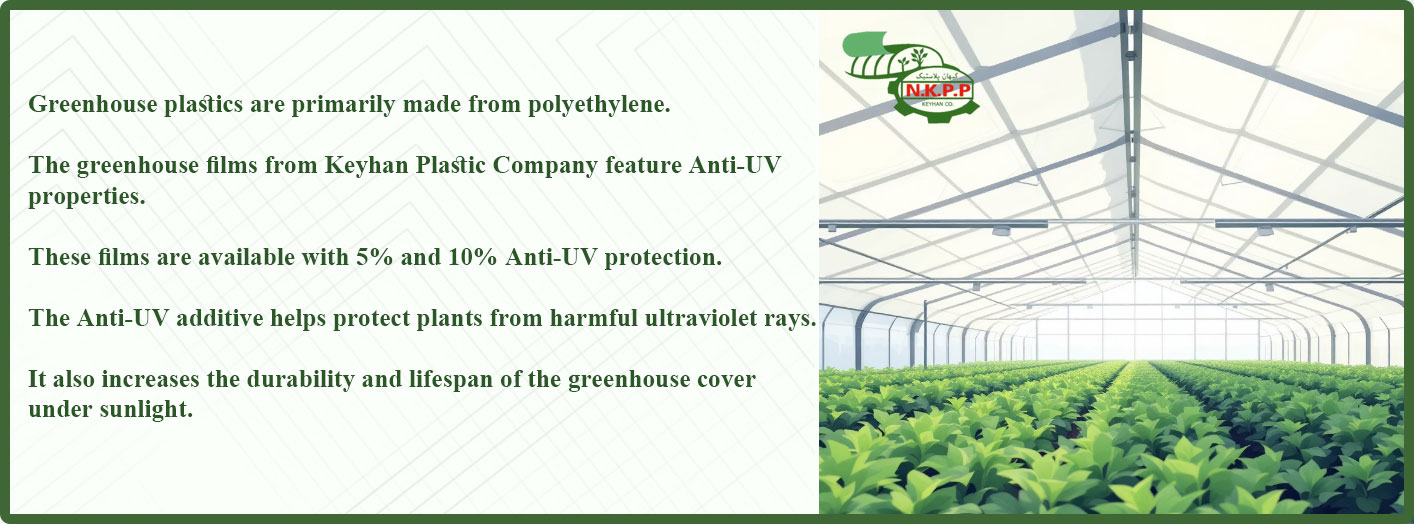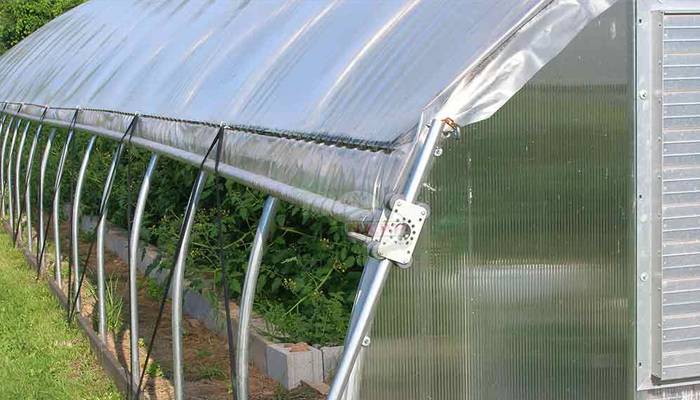Depending on the climate in their area, farmers and greenhouse owners can choose greenhouse plastics with different levels of UV protection. But what exactly is Anti-UV greenhouse plastic, and why should you consider using it? Anti-UV greenhouse film is made by adding special additives to polyethylene, which improves both its physical and chemical properties. This type of plastic is commonly used as a greenhouse cover to protect crops from harmful UV rays. In this article, we’ll explore what Anti-UV greenhouse plastic is, how it works, and the key benefits it offers for greenhouse farming.

Greenhouse plastics are mainly made from polyethylene. Keyhan Plastic Parsam Co.’s greenhouse plastic film with Anti-UV properties is produced in 5% and 10% versions. These help protect plants from ultraviolet radiation while also increasing the lifespan of the greenhouse cover against sunlight. Adding these additives does not significantly affect the weight of the film. Anti-UV greenhouse plastics are lightweight, transparent polymer films that serve as a better alternative to older traditional coverings. They are made from polyethylene, polycarbonate, or polyvinyl chloride, and are extremely flexible and durable.
Since greenhouse plastics are exposed to ultraviolet radiation, manufacturers have developed films that can absorb and stabilize UV rays, thereby extending the life of the plastic film and protecting plant health inside the greenhouse. For this reason, glass and plastic films are the two main types of covers used in greenhouse construction. Due to their excellent advantages—including lower overall costs, easy and fast installation, and superior protection of the greenhouse interior- plastic films are more commonly used.
Strength of UV-resistant greenhouse plastic
The Anti-UV stabilizer is added to the raw material during the production of greenhouse PE films. In this process, careful attention must be paid to the proper distribution of material weight. Another important factor in manufacturing is quality control, which ensures the film is produced at the highest quality level.
UV stabilizers enhance the strength and durability of greenhouse plastics. Since greenhouse films are constantly exposed to open air, different weather conditions such as storms, rainfall, and even insects and birds can damage the covering over time. However, Anti-UV greenhouse films significantly reduce the negative effects of these factors.
Anti-UV greenhouse film, as mentioned, is produced by adding UV additives to standard greenhouse plastic. The general rule is that UV additives must be combined with ordinary greenhouse films. Other additives can be added based on customer requests and needs. The UV additive protects plants and crops from harmful ultraviolet radiation. Thanks to this protective ability, Anti-UV greenhouse plastic can be recognized as one of the most efficient types of polyethylene films used in greenhouse coverings.
UV Absorbers and Stabilizers
Plastic greenhouse films containing UV absorbers have chemical compounds that absorb UV rays, preventing them from penetrating the film and entering the greenhouse. These chemical UV absorbers are often combined with UV stabilizers in the polymer matrix, which slows the degradation of plastic films exposed to UV radiation. Manufacturers have developed these additives to maximize UV protection, while still allowing enough light to enter the greenhouse for plant growth.
Effect of Ultraviolet Radiation on Plant Growth
Exposure to ultraviolet radiation damages DNA, proteins, cell membranes, and other cellular structures. Therefore, reducing UV exposure is beneficial for the long-term health of plants. In 1999, a study published in a European horticultural journal pointed out that reducing UV light in greenhouses led to deeper coloration in ornamental plants, both in flowers and leaves. This effect is valuable in commercial flower production, where uneven coloring or fading petals is considered undesirable.
Effect of UV Greenhouse Plastic on Pests
Some insects, such as aphids, are highly sensitive to ultraviolet ranges in the electromagnetic spectrum. Therefore, reducing UV penetration into the greenhouse decreases the likelihood of these pests entering, leading to fewer infestations. Similarly, when UV levels are reduced, fungi such as Botrytis and Sclerotinia produce fewer spores, which reduces the risk of fungal infections and contamination.
Drawbacks of UV Additives in Greenhouses
For greenhouse plants that rely on bees for pollination, restricting insect entry with UV-blocking films can be more harmful than beneficial. Reduced UV penetration may also negatively affect plant coloration; in some cases, vegetables may appear paler. Additionally, when improper additives are used, light transmission can decrease, negatively impacting plant growth.
Durability of Anti-UV Greenhouse Films
Adding small amounts of antioxidants to UV stabilizers increases resistance not only to harmful UV rays but also to high heat during summer. This combination prevents degradation in polyethylene, thereby significantly extending the lifespan of the film. Research shows that Anti-UV greenhouse plastic can last up to five years longer than ordinary films.
Features of Keyhan Plastic Anti-UV Greenhouse Film
Resistance against strong winds, heat, humidity, and UV radiation
Waterproof and soundproof
High adhesion
High transparency
Excellent strength and quality
Long durability of UV Greenhouse films
To enhance durability, the company uses top-grade raw materials, optimized processing conditions, and strict quality control methods. Adding UV stabilizers not only strengthens the plastic but also provides the following benefits:
- Protection of plants from harsh weather
- Faster and healthier plant growth
- Higher yield and improved product quality
- Reduction of water usage by up to 50%
- Year-round harvesting possibilities
- Better sun-drying of crops
Lower production costs for flowers, fruits, medicinal plants, and vegetables
These features make Anti-UV greenhouse plastic a practical and economical choice compared to heavy and expensive glass coverings. Still, poor-quality Anti-UV films may damage the greenhouse rather than protect it. For this reason, it is recommended to purchase UV greenhouse plastic from reputable manufacturers.
Cooling Effect of Anti-UV Greenhouse Films
Among the wide spectrum of solar radiation, infrared rays contribute most to heat transfer. If you plan to build a greenhouse in tropical regions or grow plants that require less heat, Anti-UV greenhouse films are highly recommended. Infrared radiation does not directly affect plant growth but raises greenhouse temperatures. In tropical areas, a significant difference can be observed between outdoor temperatures and those inside an Anti-UV greenhouse.
Buying Guide and Price of UV Greenhouse Plastic
As we have seen, purchasing UV greenhouse film is itself an advantage. Because of the UV additive, these films absorb and block ultraviolet rays from entering the greenhouse, protecting plants inside. However, the price of UV greenhouse plastic changes frequently due to market fluctuations. For updated prices, please contact the phone numbers below. For more information about Anti-UV additives in Keyhan Plastic greenhouse films, visit the greenhouse plastic page.




